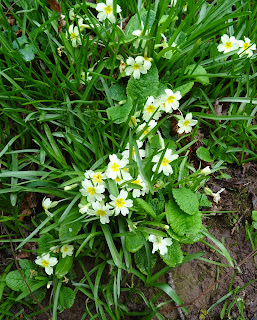Wednesday 6th April 2022, Llanymynech Heritage Centre
The “summer” season programme of the Joy of Wildlife group got off to a rather soggy start as heavy rain greeted us when we arrived at the site.
Despite the cascade of water from above we set off in hope of better things to come.
However, it did not feel that way as we wandered through the site.
Fortunately we came across the Hoffmann Kiln, one of the site’s historic buildings. Most importantly, at that moment, the structure had a roof! So, we all took advantage of this shelter to stop getting even wetter.
Inside then kiln it was perfectly dry!
The occasional foray was made into the wild wetness to see if there were any creatures, apart from us, to be eccentric enough to be out and about.
We did not find many!
The rain eased …
Then stopped …
The clouds slowly parted ...
The sun put in an appearance …
And we emerged.
The Hoffmann Kiln is continuous burning ring kiln. Information about it is summarised on the following information board.
Clicking on the image should open it in a separate window enabling the text to be read.
A second board provides more information about the working conditions, which were far from ideal.
And the roof?
It was part of the original construction to keep the quicklime dry.
The chimney is at the far end of the kiln and makes it presence felt throughout the site.
Although the industrial buildings form a major focus for the site, there are also extensive meadows, woodland, the Montgomery Canal and The Canal and River Trust visitor centre.
Grateful for the shelter and interest the kiln had provided, we moved into one of the meadows.
Given the time of year we did not expect much of obvious floral interest but there were a few cowslips in evidence.
Whilst others busied themselves in the meadows I wandered into the woods and came across large patches of primroses;
And wood anemone.
The rest of the group had been busy during my brief wander:
A staphylinid beetle, Stenus bimaculatus;
 |
| Photograph: David Williams |
A springtail stalking beetle, Notiophilus rufipes;
 |
| Photograph: Nigel Cane-Honeysett |
A ground beetle, Oxypselaphus obscurus;
 |
| Photograph: Nigel Cane-Honeysett |
And a cowslip/primrose hybrid.
We were by a bench and it was just the right time of day so we had lunch.
In the afternoon we continued looking at the meadows and the rougher vegetation that surrounded each one.
Staphylinid beetles were plentiful. Here are a couple more that have been identified:
Tachyporus obtusus;
 |
| Photograph: Nigel Cane-Honeysett |
And Paederus riparius.
 |
| Photograph: David Williams |
Gravity drew us to the lower meadow. This grassland bordered the Montgomery Canal and its lowly position made it much wetter. The meadow had a small pool.
The water in the pool was pretty clear and we could see several newts swimming about.
Seeing the newts in the water was easy but being able to photograph them, as they swam below the surface of the water, was far more difficult! However with a dedicated effort the following photographs of a couple of species were obtained. These show the difference between the hind feet of breeding male smooth and palmate newts:
Smooth newt;
 |
| Photograph: David Williams |
Palmate newt.
 |
| Photograph: David Williams |
In the denser border vegetation of the meadow a bee-fly, Bombylius major, was taking a brief pause from its normal frenetic (to human observers) behaviour.
Looking up from the bee-fly one was immediately reminded of the sites industrial past.
Nearby, a 10-spot ladybird was dislodged, photographed, then returned to its abode.
 |
| Photograph: David Williams |
A search of the longer grass and other vegetation close to the pool yielded another ladybird, Coccidula rufa.
 |
| Photograph: David Williams |
We left the meadow at the end furthest from the cars and walked back to the starting point along the canal towpath, pausing for one last look at the dominating chimney.
And finally the Wednesday Weevil of the Week, which was found in the vegetation bordering the canal, Notaris scirpi.
 |
| Photograph: Emm Cane-Honeysett |
My thanks to Shropshire County Council and the Canal and River Trust for permission to visit the site and to the photographers who have provided their images.
Other news
From a holidaymaker in Crete I have been sent the following photographs:
A pair of groundbugs, Spilostethus pandurus.
 |
| Photograph: John Lyden |
These have been found occasionally in Britain but the records are attributed to natural immigrants and accidental introductions.
And a weevil, that had it not been found on a different day would be a rival to the Wednesday Weevil of the Week, Lixus pulverulentus.
 |
| Photograph: John Lyden |






.JPG)
































No comments:
Post a Comment
Please feel free to comment on this post...